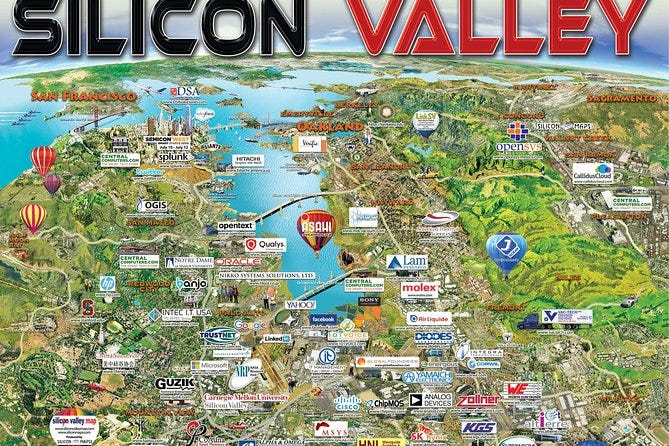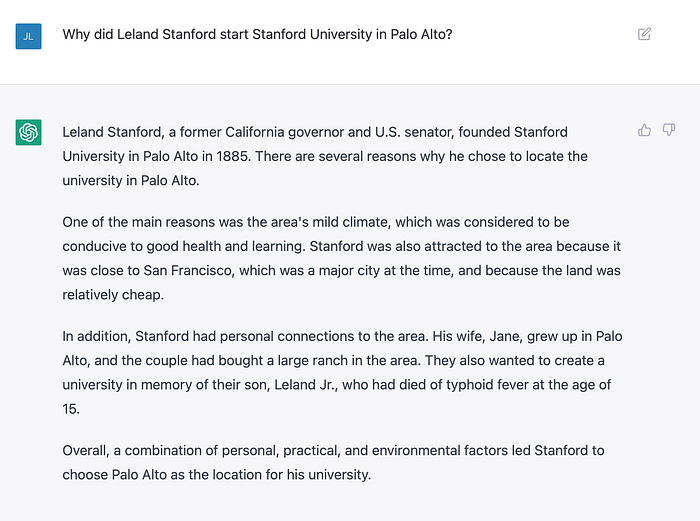

Giving Thanks To Silicon Valley
source link: https://mondaynote.com/giving-thanks-to-silicon-valley-e459beb1aa83
Go to the source link to view the article. You can view the picture content, updated content and better typesetting reading experience. If the link is broken, please click the button below to view the snapshot at that time.
Giving Thanks To Silicon Valley
by Jean-Louis Gassée
Now a happy grandfather, I have the time and freedom of mind to gratefully reflect upon my move to Silicon Valley more than 35 years ago.

Long Thanksgiving drives to and from Palm Springs and Joshua Tree National Park with family members give rise to grateful thoughts as passengers doze off. Perhaps in reaction to opinion pieces that scapegoat Silicon Valley whenever there’s an economic downturn, my musings focused on the gratitude and affection I feel for my adopted home.
The relationship started in 1968. I was 24 years old when I joined Hewlett-Packard to help launch the French battalion of what turned out to be a precursor of the PC revolution. I didn’t know it at the time, but I had chanced upon the successful, competent, and benevolent primogenitor of what we now call Silicon Valley. Dave Packard’s elegant description of the company’s culture in The HP Way enticed me to escape the non-jobs I had experienced so far.
Two years later, November 1970, I landed at the local Palo Alto airport on Packard’s Raytheon jet, a night flight from the company’s calculator facility in Loveland, Colorado. My first visit to the US — and to the Peninsula that would become my home — solidified my determination to become part of the US tech brotherhood.
But let me back up. Some years earlier my father left home escorted by two gendarmes. My mother being on the other side of the planet, I had to fend for myself. No complaints, I gained street smarts, primarily from the colorful characters who would help me along the way.
Paris was home, but I harbored a pro-America prejudice. Journalist and press lord Jean-Jacques Servan-Schreiber had just published an enormous best-seller, The American Challenge (Le Défi Américain), from which I gathered two ideas: America was “it”, the land of opportunity; and, contrary to France’s rigid caste system, America had a more flexible, “classless” society where I’d be judged for what I did, not where I came from or where my father ended up. I had indeed started on the track to become a brahmin of sorts, but my father’s adventures had left me on the roadside with just a junior degree in math and physics, I needed a different ladder. I found it at HP.
During my next visit to Loveland in 1972, I politely inquired about a job in the labs. Bishop Bob Watson, the engineering manager was, as always, very nice but diplomatically let me know that my (still emerging) success in sales wasn’t conducive to a post in his shop.
(I would meet Bob again more than 15 years later when he came to Cupertino with Dick Hackborn, the founder of HP’s Inkjet Printer operation in Boise, Idaho, to discuss building printers for Apple. Nothing came of it, but, a few years later at Be, we hired his daughter Diane. Dick, a Microsoft director at the time, thought highly of Be’s efforts.)
Instead of heading to the lab, I was promoted to a staff position in the European HQ near Geneva, Switzerland…only to discover that I’m not genetically destined for a desk job. I left HP — but not my dream — in 1974. It would be another seven years before I would visit Silicon Valley again.
After I started Apple France in late 1980, our family finally moved to the Valley in 1985. I told my reluctant spouse: “It’s only for two or three years”…
Apple years followed, then the Be decade, followed by years in the Venture brotherhood, and now a happy grandfatherhood that allows me to peacefully contemplate the dimensions of my debt to the Valley that has become our home.
In 1968, the term Silicon Valley hadn’t yet entered the vocabulary, Intel had just been started by ex-Fairchild engineers Gordon Moore (of Moore’s Law fame) and Bob Noyce with an investment of… $2.5M (yes, millions, not billions). Fairchild itself had been founded by the “Traitorous Eight”, a group of Shockley Semiconductor Laboratory engineers who could no longer tolerate William Shockley’s difficult personality, which personality shouldn’t darken our praise for his co-invention of the transistor while at Bell Labs before starting his company in Mountain View.
All of these companies — H-P (founded in 1938), Shockley, Farichild, Intel — thrived in the same Santa Clara County “neighborhood”, a concentration of brains, technology and money that came to repeatedly change the world.
As I drive, I amuse myself with my hypothesis that Silicon Valley started where it did because of meteorological factors…
San Francisco summers are notoriously cold. Dressed for the California sunshine, I froze in the biting wind during my first August 72 visit to the city, only to see the temperature rise nicely as I drove south on the 280 freeway to Cupertino. So this was why well-to-do San Franciscans in the 19th century — Leland Stanford among them — maintained summer residences down the Peninsula.
In 1885, Stanford, a railroad magnate, picked the pleasant town of Palo Alto for the location of his eponymous university. In 1938, Stanford Professor of Engineering Frederick Terman persuaded Bill Hewlett and Dave Packard to start their company on Stanford land. Et voilà, Silicon Valley!
Just in case you think the Provigil I took (with a prescription) to keep awake at the wheel made me see things, this is what I found when having the following dialog with a “thing” at chat.openai.com (it’s easy to get an account and generate interesting or bizarre dialogs now all over Twitter):

My 1968 hopes have been more than fulfilled, starting with a rich professional life and material comfort that, among other things, makes us the proud parents of three adult children who made good use of institutions of higher learning without being saddled with student loans. And there is my wife Brigitte who has become an A-to-Z designer and developer of elegant homes.
I’m also grateful for having become bi-cultural, equally enjoying (and being frustrated) by both Valley and French cultures. It’s nice to be able to occasionally keep a friendly distance from the temptations of radical opinions.
And there is the spiritual dimension with the help (more abundant, diverse and humane than in France) of local sages, including access to what is sometimes called consciousness medicine, eloquently discussed by authors such as Michael Pollan in his popular How To Change Your Mind book.
Back from our Thanksgiving road trip, I fall back to Earth after finishing Rick Wartzman’s Still Broke, a book that reviews Walmart’s transformations and expands to the ways that American society treats front-line workers, too often leaving them unable to earn a decent living wage. (The audiobook version is skillfully voiced by the very author.)
Not to join the chorus of scapegoaters, but despite the decades of innovation and financial success, the Valley seems to have done less than nothing to reduce inequalities. Even in rich, ostensibly benevolent Palo Alto, service workers, teachers and cops can’t find affordable housing. (Along that line of thought, see Scott Galloway’s book titled Adrift: America in 100 Charts that succinctly draws a bleak picture.)
Grateful as I am, I wonder how long this can last.
Recommend
About Joyk
Aggregate valuable and interesting links.
Joyk means Joy of geeK